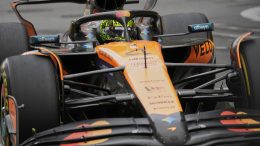The recent discussion surrounding Pirelli’s full wet tyres has ignited a storm in the Formula 1 world, with drivers and fans alike voicing their concerns about their effectiveness.
At the heart of the debate is the apparent uselessness of full wet tyres, which were mandatory for the Saturday sprint at Spa Francorchamps when the race started behind the safety car.
In a surprising twist, even Pirelli’s F1 boss, Mario Isola, understands the drivers’ frustration and does not disagree with their criticism. Almost the entire field made a beeline for the pits as soon as the safety car retreated, opting for intermediate tyres that proved to be significantly faster.
George Russell, the Mercedes driver and Grand Prix Drivers’ Association director, was vocal about his discontent with the full wets.
“Those tyres are probably six, seven seconds a lap slower than the intermediates,” Russell exclaimed, highlighting their lack of competitiveness. He argued that full wet tyres should only be necessary when there is a high risk of aquaplaning on the intermediates, calling for substantial improvements to address the issue.
Taking heed of the drivers’ feedback, Pirelli is already on the case, brainstorming the concept of a ‘super intermediate’ or ‘intermediate-plus’ tyre for future races. Isola revealed that Pirelli has indeed made strides in improving the performance of full wet tyres recently, but the larger concern lies in the reluctance of race directors to allow racing action in very wet conditions.
Addressing the dilemma, Isola emphasized the importance of evaluating the drivers’ perspectives while working collaboratively with the teams and the FIA. He candidly questioned whether the full wet tyres should solely serve as safety car tyres or if efforts should be directed towards reducing tyre spray, allowing drivers to race more effectively on full wets.
For the time being, the situation seems unclear, leaving Pirelli pondering the best way forward. Isola suggested the possibility of maintaining both intermediate and full wet tyres if measures can be taken to enhance their use in different conditions. However, if the full wet tyres continue to be restricted to safety car situations, their purpose would undoubtedly become redundant, echoing the sentiments of the drivers.
The ball is now in Formula 1’s court to decide the path they wish to pursue. Will they work together with Pirelli to create a revolutionary ‘super intermediate’ solution, allowing drivers to showcase their skills on wet tracks more effectively? Or will they consider other avenues to enhance the utility of full wet tyres?
As the discussions unfold, one thing remains certain: Formula 1’s thirst for innovation and improvement will continue, fueled by the collective efforts of drivers, teams, and Pirelli to make the sport even more thrilling and competitive in all weather conditions. Stay tuned as Formula 1 ventures into uncharted territory, seeking to redefine the art of racing on wet tracks.













